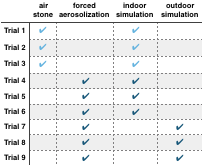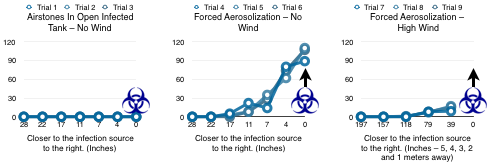Aerosol dispersal of the fish pathogen, Amyloodinium ocellatum
Aquaculture, Volume 257, Issues 1–4, 30 June 2006, Pages 118-123
Ashley Roberts-Thomson, Andrew Barnes, D. Stewart Fielder, Robert J.G. Lester, Robert D. Adlard
PDF Available
They performed three sets of tests to see how “suseceptible” a tank or pond could be when placed “close” to infected tanks:
- The first set was more or less a typical indoor home aquarium setup.
- The second set was an indoor setup, but force-aerosolized the infected water.
- The third set was more typical of a pond system and simulated outdoor windy conditions and also force-aerosolized the infected water.
This is a table I prepared to show the organization of their trials into three sets of experiments:

The goal of their experiments was to prove whether Amyloodinium can “ride” a water droplet to a foreign body of water and arrive intact enough to infect fish.
They did this successfully, and indeed Amyloodinium can “ride” water droplets. But that might not be the most interesting part to us in the reefing community.
Here are some charts I made which depict the reported results for the three sets of experiments:

The first thing that jumps out at me – from the first chart – is that airstones running in an open tank like a stereotypical home setup are totally unable to spread dinospores.
As it turns out, dinospores are relatively big and subject to hypersalinity and dehydration while in transit. It took a lot more than bubbles in a fish tank to achieve transmission – they need a lot of help to get anywhere successfully!

The second and third chart demonstrate the successful conditions.
Without strong wind, dinospores were only infective out to a maximum of 17 inches from the source tank.
Forced-arosolization was implemented in these two experiments by spraying 2 liters of dinospore-infected water into the air through a hand-pumped sprayer somewhat like the one depicted to the left, fitted with a misting nozzle.




